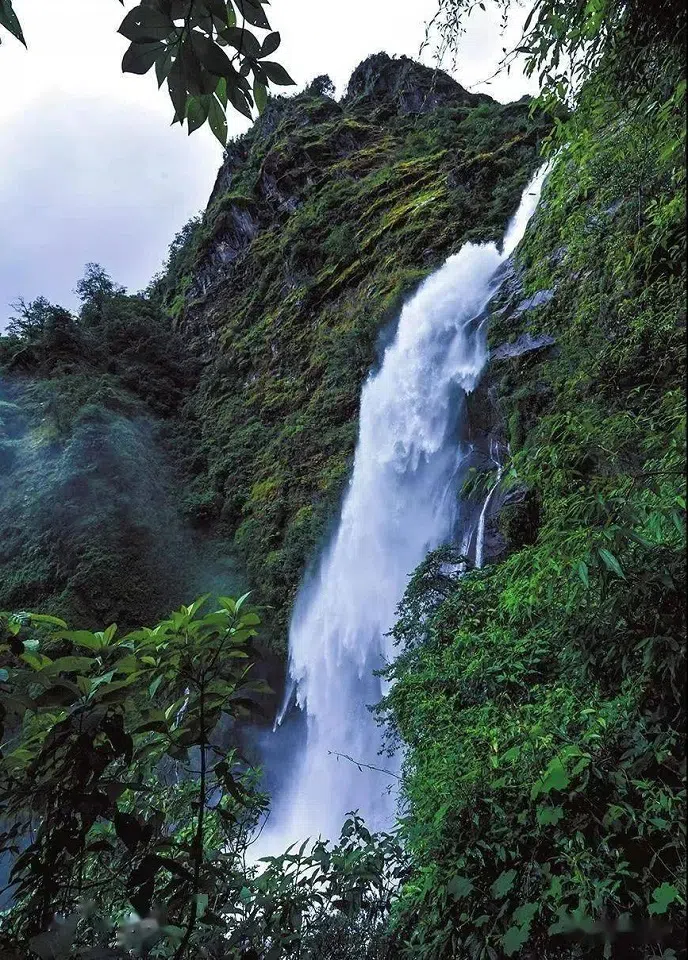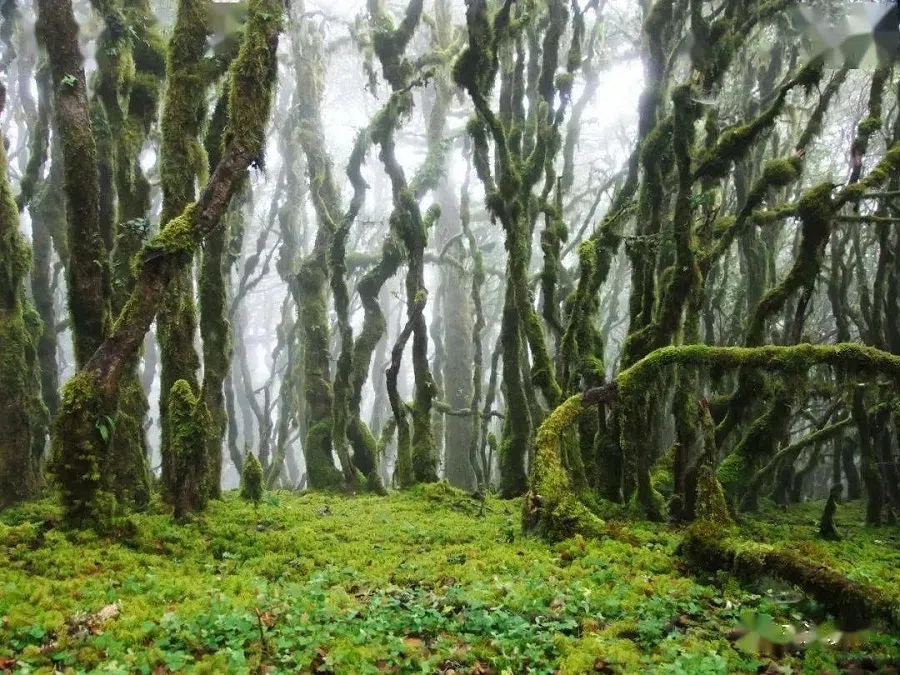China’s Ailao Mountains: Preserving nature in the age of oversharing
With the Ailao Mountains experiencing a surge in visitors driven by social media, Chinese academic Zhang Tiankan argues that preserving the range’s mystery and pristine condition is more beneficial for humanity.

A video of a blogger exploring and collecting materials in the Ailao Mountains recently went viral, bringing the area back into the public eye and trending on social media.
Viewers were astonished by the thrilling scenes in the video, feeling as if they were watching an adventure film. Subsequently, crowds of curious tourists chose to explore this mysterious niche area during the National Day holiday.

The originally secluded restricted zone became a crowded scenic spot due to the influx of people. On 3 October, the account “Wonderland of Yunnan Ailao Mountains” (云南哀牢山仙境) posted a video claiming that the Ailao Mountains saw “100 million visitors” during the holiday.
Natural and cultural magnetism
On 6 October, the Chuxiong Management Bureau of the Ailao Mountain Nature Reserve and the Shuangbai County Management Sub-Bureau issued three announcements, reminding the public that all unauthorised human activities in the nature reserve are prohibited. They strictly forbade activities including hiking, climbing, adventuring, crossings and camping in the reserve.
According to Article 34 of the Regulations of the People’s Republic of China on Nature Reserves, unauthorised movement or destruction of nature reserve boundary markers, as well as entering the reserve without approval or failing to comply with management authority regulations, can result in a correction order from the management authority and a fine ranging from 100 RMB to 5,000 RMB (US$14 to US$702).

While the claim that the Ailao Mountains attracted “100 million tourists” may be exaggerated, the area’s mystery and pristine nature likely did draw a large number of visitors eager to admire its beauty or explore its depths. Curiosity is a shared human trait, and the Ailao Mountains’ pristine state and mystique, along with its rich natural and cultural history, have a magnetic appeal.
The true beauty of the Ailao Mountains is certainly worth appreciating and exploring, but it is essential to heed the local management’s warnings. A fundamental respect for nature is necessary; visitors should stick to the established routes and avoid venturing into undeveloped areas. Safety must come first.
Beyond wild animals, the mountains present complex terrain, unpredictable weather and harmful pathogens. Elements like air, temperature and microorganisms necessitate special caution, all of which are intrinsic to the mountains’ natural and cultural environment.
... it is said that Ailao Mountain derives its name from the ancient Ailao tribe that flourished in the area. However, “Ailao” (哀牢) does not come from Chinese; rather, it is a transliteration from the local language.
Origins of the name ‘Ailao’
An exploration of the semantics and origins of the name “Ailao Mountains” reveals a deep and mysterious significance. Located in Jiasa town in the Xinping Yi and Dai autonomous county of Yunnan, the Ailao Mountains were designated as a national nature reserve in May 1988.
The reserve covers five counties — Chuxiong, Shuangbai, Jingdong, Zhenyuan, and Xinping — and is dedicated to protecting the subtropical montane moist evergreen broadleaf forest ecosystem, along with precious wildlife like the black gibbon, green peafowl, and Phayre’s leaf monkey.

Traditionally, it is said that Ailao Mountain derives its name from the ancient Ailao tribe that flourished in the area. However, “Ailao” (哀牢) does not come from Chinese; rather, it is a transliteration from the local language.
The Ming dynasty record History of Yunnan by Zhuge Yuansheng notes that Ailao Mountain was originally called Anle (安乐, peace and happiness) but was mispronounced in the Yi language as Ailao. During the Qing dynasty, the southern section of the mountains, originally known as Mengle Mountain, was already referred to as Ailao Mountain.
... the ancient and mysterious Ailao Kingdom had a tradition of “younger son succession”, suggesting a cultural reverence for the youngest child. This connection infuses the name Ailao Mountains with a sense of warmth and respect.
The naming of the Ailao Mountains may also come from local customs. Elders in the region affectionately refer to their youngest sons as Alao, which phonetically resembles Ailao. Moreover, it is said that the ancient and mysterious Ailao Kingdom had a tradition of “younger son succession”, suggesting a cultural reverence for the youngest child. This connection infuses the name Ailao Mountains with a sense of warmth and respect.

Another theory suggests “Ailao” (哀牢) means “a people fond of wine” in the languages of the Bo and Baiyue ethnic groups. “Ai” (哀) meant “wine” in the now-extinct Bo languages of the Ailao Mountain region, while “Lao” (牢) also meant “wine” in some Baiyue languages. Therefore, it is speculated that Ailao is a phonetic expression in Chinese representing the ancient affinity for alcohol among the Bo and Dai peoples. This suggests that Ailao is not a direct translation in Chinese, but rather a transliteration that has evolved over time.
In November 2021, four experienced national geologists, tasked with a national forest resource survey, ventured deep into the Ailao Mountains. However, contact was lost just a day after they entered the mountains.
Resembling a great dragon
Of course, the wonder of Ailao Mountain lies in its pristine nature and its spanning of several climatic zones. The Ailao Mountains form a massive mountain range that stretches across central Yunnan, resembling a great dragon that separates the Yungui Plateau from the Hengduan Mountains.
The range features more than 20 peaks soaring more than 2,000 metres above sea level, with the main peak reaching an altitude of 3,166 metres. This topographical structure creates a unique vertical climate distribution in the Ailao Mountains. From the base to the summit, one traverses multiple climatic zones, ascending from the hot South Asian subtropical zone to the cooler temperate zone.
This climatic diversity fosters a rich biological diversity: the foothills are covered in tropical rainforest, the mid-elevations host evergreen broadleaf forests, and the summit is characterised by coniferous forests and shrubs.
The Ailao Mountains also resemble a green maze with its complex terrain and dense vegetation. Besides valuable wildlife such as black gibbons, green peafowls and Phayre’s leaf monkeys, the mountains are also home to wild boars and black bears, which can pose dangers to those venturing into the area.

Besides the complex terrain, the Ailao Mountains are also known for its unpredictable weather. A clear sky can quickly turn into dense fog, especially from September to March. Heavy rain, thunderstorms and hail are common, and the mountain experiences significant temperature fluctuations between day and night, coupled with high humidity, making hypothermia a very likely risk.
Ailao Mountain releases a large amount of carbon dioxide at night, especially during foggy weather. If individuals walk in the forest for an extended period, they could potentially lose consciousness due to oxygen deprivation, leading to hypothermia.
Uncharted dangers
There are various theories regarding fatalities due to hypothermia. One is carbon dioxide, while another is a strong magnetic field. In November 2021, four experienced national geologists, tasked with a national forest resource survey, ventured deep into the Ailao Mountains. However, contact was lost just a day after they entered the mountains.
When search and rescue teams eventually discovered their bodies, they were found to have suffered from hypothermia.
Now, there are many guesses as to the reason, one of which is that Ailao Mountain releases a large amount of carbon dioxide at night, especially during foggy weather. If individuals walk in the forest for an extended period, they could potentially lose consciousness due to oxygen deprivation, leading to hypothermia.
A second theory arose when rescuers measured the magnetic field in the area and discovered that it was twice as strong as that in Sichuan’s Heizhugou region. This has led to speculation that the four individuals may have been disoriented due to magnetic field interference, failed to recognise the dangers and finally succumbed to hypothermia.

They could have also been suddenly hit by a cold front and thick fog, causing them to lose their way and ultimately leading to hypothermia and their tragic fate.
For a natural scenic treasure like the Ailao Mountains, it is best to observe rather than venture into its depths — or better yet not to disturb it at all, allowing it to exist free from human interference.
Scientists proposed the Global Deal for Nature in 2017, advocating for humans to set aside half of the Earth for nature, including other plants and animals, suggesting that it would be sufficient for humanity to inhabit and utilise only half of the planet’s surface. Therefore, maintaining the mystery and pristine state of the Ailao Mountains is in line with the Global Deal for Nature and also more beneficial for humanity.





